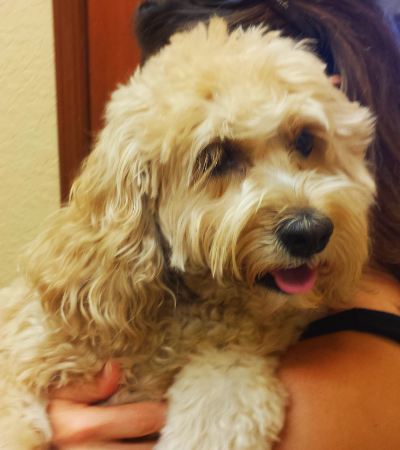Pet Emergency Care
PET EMERGENCY CARE THOUGHTS
From my perspective, pet emergency care is one of the most difficult aspects of medicine yet the most rewarding. A Doctor does not have much time to think but must “act” NOW! Life and death can hinge on seconds. I never have been a patient man but that quality has served me quite well on pet emergency care cases. I just don’t fiddle around. If something I am doing is not working, I keep on trying. I have been known for years as a Doctor that fights for his patients.
Take Chewy, a beautiful Wheaten Terrier, pictured on the right. She was at the ER and stabilized until transported to me the following morning at a hospital in Broward County, FL where I was working. In short order I diagnosed her with Auto-Immune Hemolytic Anemia; a severe blood disorder seen in man and animals that destroys the body’s red cells. It took a about a week but she improved to the point where I could discharge her. She had not eaten in over a week so the following day I brought rotisserie chicken for her and she almost took my hand off trying to get to the meat!! Deep down, I knew I did it. Chewy was going home. Her family sure missed her. The “hover” shot was taken in April; four months after discharge. A very loved dog and an ecstatic veterinarian!
BE SURE YOU KNOW WHERE TO GO
Everything is fine and dandy when your pet is healthy and romping around with the kids. What if something happens to the animal after your veterinarian office is closed? In Choosing a Veterinarian I wrote about the importance of knowing where to go when you suspect an emergency situation. Find out the alternatives. There are veterinary practices that take their own pet emergency care cases. Others are in a group and divide up the days so everyone is covered. Most common, particularly in larger cities, the veterinary office refers everything to a strict after hours emergency center. The dog or cat is stabilized and the following day usually sent back to the referring veterinarian. So find out your situation and know how much time it takes to get to an emergency facility.
IS IT REALLY AN EMERGENCY?
The toughest thing for a client is wondering whether something is an emergency or not. If a dog is hit by a car, extreme breathing difficulties, blood coming out from any orifice; those are obvious. Yes, you take your pet to the ER. If it is over the weekend and you see your male cat straining in the litter box, take it to the ER. It may be obstructed and unable to urinate. A pregnant female animal straining to deliver her offspring? Take it to the ER. Always call ahead. If unsure, the Doctor on duty can decide whether you have a true emergency or not. After years of taking such phone calls, I always recommend that it is better to be on the safe side, if in doubt, and have the animal examined. If it is something minor and treatable that day, the expense of any emergency visit fee is minimal compared to the piece of mind you get. Pet emergency care is there when you need it the most!
PET EMERGENCY CARE KIT
Pet owners can keep a pet emergency care kit around for minor situations such
as cuts and scrapes. I would recommend that people keep around in a container marked “Pet Emergency Supplies”, the following:
- Rectal Digital Thermometer- Normal Dog/Cat. 101.5-102.0 F
- Gauze
- Elastic Bandage from drug store
- Blanket to wrap and transport pet
- Triple antibiotic cream from drug store.
- Benedryl or Dramamine tablets for insect bites.
- Bandage Scissors
- NEVER, EVER GIVE ASPIRIN OR TYLENOL® TO A CAT.
- Contact lens solution (0.9% saline) for flushing eyes and cleaning wounds.
- Hydrogen Peroxide. If needed to induce vomiting. From local drug store.
HANDLING AN INJURED ANIMAL
The most important thing to understand is that when an animal is injured it is hurting and if not handled correctly will bite; not out of malice but because it is hurting. If the animal has a broken leg gently lift the animal and put it in the car on the opposite side of the body. Problems breathing? Do not pick up the animal by the chest. Support the animal from the neck and behind the rib cage. Suspect a back injury? Gently move the animal on to a stiff board for transport so as not to do any unnecessary moving that might cause further damage. If needed, you may loosely tie a bandanna over the muzzle to form a gentle muzzle. The take away thought here is to safely get the injured animal to the medical office without endangering family members or inflicting further damage to the animal.





